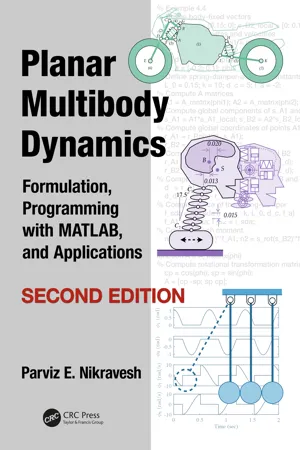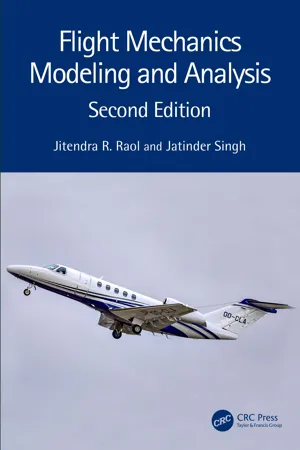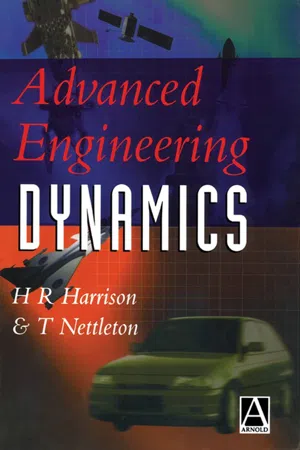Technology & Engineering
Planar Kinetics of a Rigid Body
Planar kinetics of a rigid body involves the study of forces and motion in a two-dimensional plane. It focuses on analyzing the forces and moments acting on a rigid body and their resulting motion. This field of study is essential for understanding the behavior of objects in motion and is widely used in engineering and physics for designing and analyzing mechanical systems.
Written by Perlego with AI-assistance
Related key terms
4 Key excerpts on "Planar Kinetics of a Rigid Body"
- eBook - ePub
Planar Multibody Dynamics
Formulation, Programming with MATLAB®, and Applications, Second Edition
- Parviz Nikravesh(Author)
- 2018(Publication Date)
- CRC Press(Publisher)
3Fundamentals of Planar Kinematics
This chapter presents a summary of some fundamental concepts of planar kinematics. We first review the kinematics of a single particle, and then we consider the fundamental formulas for the kinematics of a single planar rigid body. Definitions for arrays of coordinates, constraint equations, degrees of freedom, and kinematic joints are also discussed.The kinematic definitions and fundamental formulas for kinematics of particles and rigid bodies that are discussed in this chapter will be used extensively throughout this textbook. Therefore, it is important to understand these simple but fundamental formulas at this point. Exercises with MATLAB® are provided to carry out most of the computations, even though most of the examples are very simple and the calculations may be performed on paper. It is our intent to use MATLAB as much as possible and be prepared to solve more complex and realistic problems whenever needed.3.1 A Particle
The simplest body arising in the study of motion is a particle , or a point mass . Analysis of the behavior of a point mass can lead to the kinematic and dynamic analysis of a body, and eventually to the analysis of a system of bodies. Therefore, it is essential to study the kinematics of particles first. In this textbook, we use the terms particles and points interchangeably.3.1.1 Kinematics of a Particle
The most fundamental step in planar kinematics is to describe the position of a particle or a point in a plane. A plane is described by a nonmoving Cartesian reference frame x–y . The position of a typical particle A in the plane is described by vectoras shown in Figure 3.1 . The components of the position vectorr →A, or the x–y coordinates of particle Ar →A - eBook - ePub
- Jitendra R. Raol, Jatinder Singh(Authors)
- 2023(Publication Date)
- CRC Press(Publisher)
3 ]. The chapter ends with a simplified explanation of the physics behind the working of gyroscope.2.2 Kinematics
The kinematics is concerned with the static aspects of mechanics wherein the inherent cause of the motion is not taken into account.2.2.1 Rectangular Cartesian Coordinates
Rectangular Cartesian coordinates are associated with orthogonal xyz axes that are right-handed by convention. Such coordinates are generally used to define position, velocity, and force vectors. For instance, position vector can be defined in terms of its components x, y, and z. Figure 2.1 shows the components of the position vectorR →. Assuming that the components ofR →vary with time, the position vectorR →can be expressed asFIGURE 2.1 Rectangular Cartesian coordinates.(2.1)R →= x( t )i ^+ y( t )j ^+ z( t )k ^wherei ^,j ^, andk ^are unit vectors. It is easy to obtain the velocity vector by differentiating (2.1) for position vector.(2.2)V →= u( t )i ^+ v( t )j ^+ w( t )k ^Further differentiation of the equation forV →shall provide the acceleration(2.3)a →=a x( t )i ^+a yj ^+a zk ^Here,u =,x ˙v =,y ˙w =; andz ˙,a x=x ¨,a y=y ¨a z=z ¨ - eBook - ePub
General Physics
Mechanics and Molecular Physics
- L D Landau(Author)
- 2013(Publication Date)
- Pergamon(Publisher)
CHAPTER IIIMOTION OF A RIGID BODY
Publisher Summary
This chapter discusses some types of motion of a rigid body. In mechanics, rigid body means that the relative position of the parts of a body remains unchanged during the motion. The body, thus, moves as a whole. The simplest motion of a rigid body is one in which it moves parallel to itself; this is called translation. For example, if a compass is moved smoothly in a horizontal plane, the needle will retain a steady north-south direction and will execute a translational motion. In translational motion of a rigid body, every point in it has the same velocity and describes a path of the same shape, there being merely a displacement between the paths. Another simple type of motion of a rigid body is rotation about an axis. The chapter describes the energy of a rigid body in motion, rotational angular momentum, gyroscope, and inertia forces.§25. Types of motion of a rigid body
So far we have considered the motion of bodies which might be regarded as particles under certain conditions. Let us now go on to consider motions in which the finite size of bodies is important. Such bodies will be assumed to be rigid . In mechanics, this term means that the relative position of the parts of a body remains unchanged during the motion. The body thus moves as a whole.The simplest motion of a rigid body is one in which it moves parallel to itself; this is called translation . For example, if a compass is moved smoothly in a horizontal plane, the needle will retain a steady north-south direction and will execute a translational motion.In translational motion of a rigid body, every point in it has the same velocity and describes a path of the same shape, there being merely a displacement between the paths.Another simple type of motion of a rigid body is rotation about an axis. In rotation, the various points in the body describe circles in planes perpendicular to the axis of rotation. If in a time dt the body rotates through an angle dφ , the path ds traversed in that time by any point P of the body is clearly ds = r dφ , where r is the distance of P from the axis of rotation. Dividing by dt , we obtain the velocity of P - eBook - ePub
- H. Harrison, T. Nettleton(Authors)
- 1997(Publication Date)
- Butterworth-Heinemann(Publisher)
4Rigid Body Motion in Three Dimensions
4.1 Introduction
A rigid body is an idealization of a solid object for which no change in volume or shape is permissible. This means that the separation between any two particles of the body remains constant.If we know the positions of three non-colinear points, i, j and k , then the position of the body in space is defined. However, there are three equations of constraint of the form |ri −rj| = constant so the number of degrees of freedom is 3 × 3 − 3 = 6.4.2 Rotation
If the line joining any two points changes its orientation in space then the body has suffered a rotation. If no rotation is taking place then all particles will be moving along parallel paths. If the paths are straight then the motion is described as rectilinear translation and if not the motion is curvilinear translation. From the definitions it is clear that a body can move along a circular path but there need be no rotation of the body.It follows that for any pure translational motion there is no relative motion between individual particles. Conversely any relative motion must be due to some rotation.The rotation of a rigid body can be described in terms of the motion of points on a sphere of radius a centred on some arbitrary reference point, say i . The body, shown in Fig. 4.1 , is now reorientated so that the points j and k are moved, by any means, to positions j′ and k′ . The arc of the great circle joining j and k will be the same length as the arc joining j′ and k′, by definition of a rigid body. Next we construct the great circle through points j and j′ and another through the points k and k′ . We now draw great circles which are the perpendicular bisectors of arcs jj′ and kk′ . These two circles intersect at point N. The figure is now completed by drawing the four great circles through N and the points j, k, j′ and k′ respectively.Fig. 4.1By the definition of the perpendicular bisector arc Nj = arc Nj′ and arc Nk = arc Nk′ . Also arc jk = arc j′k′ and thus it follows that the spherical triangle k Nj is congruent with k′ Nj′ . Now the angle k Nj = k′ Nj′ and the angle k Nj′ is common; therefore angle k Nk′ = j Nj′
Index pages curate the most relevant extracts from our library of academic textbooks. They’ve been created using an in-house natural language model (NLM), each adding context and meaning to key research topics.



